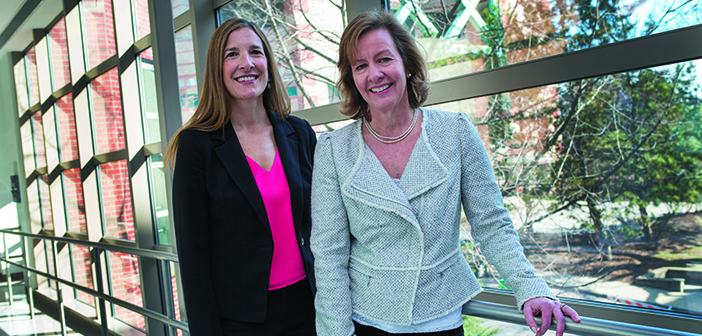Pediatric asthma researchers are scaling up successful local programs to create a national model.
For more than two decades researchers at Brown have honed their approach to preventing and reducing asthma symptoms among children in Rhode Island. Now, with an $8 million grant from the National Heart, Lung, and Blood Institute, they can expand their pilot programs to reach 1,500 city kids and their families.
Elizabeth McQuaid, PhD, and Daphne Koinis-Mitchell, PhD, who are coprincipal investigators of the six-year project, have developed evidence-based programs that improve outcomes, including better asthma control, fewer emergency department visits, lower incidence of complications like allergies and poor sleep, and fewer missed school days. They’re building on the success of these initiatives to establish the Rhode Island Asthma Integrated Response Program (RI-AIR).
“We’re not testing whether these interventions work. We know they work,” says McQuaid, a professor of psychiatry and human behavior and of pediatrics (research). Instead, they’re evaluating potential barriers, sustainability, and cost effectiveness, to ensure they reach as many kids as possible. RI-AIR is one of just four centers in the country to receive the NHLBI grant, which aims to reduce childhood asthma disparities.
Asthma is more prevalent in cities, and further exacerbated in low-income housing, which is more likely to harbor triggers like mold and pests. Furthermore, a disproportionately high number of minority children live in such housing. Beyond immediate health impacts, asthma is linked to lower educational achievement, physical activity, even social engagement.
“It’s not just about asthma. It’s about all the other outcomes,” says Koinis-Mitchell, associate professor of psychiatry and human behavior and of pediatrics (research). Helping families to play an active role in their children’s care, from removing triggers to partnering with their kids’ health care providers, has been critical to the success of their pilot programs.
One long-running intervention is the Community Asthma Program at Hasbro Children’s Hospital, of which Koinis-Mitchell is director. Since 1997, it’s educated children with asthma as well as their families and school staff about how to identify symptoms, avoid triggers, and use their medications through partnerships with Providence-area schools and at Hasbro Children’s Hospital.
For kids with severe, poorly controlled asthma, the Home Asthma Response Program, founded in 2010, offers a more tailored approach. “Our staff go out to the homes and work with the families directly,” McQuaid says, going over physicians’ action plans “step by step,” spotting potential triggers, and giving families “actual strategies” so they’re empowered to take action.
These programs reached about 1,000 families annually, resulting in fewer ED visits and inpatient stays. Then, two years ago, McQuaid and Koinis-Mitchell got a key boost: seed funding from the Hassenfeld Child Health Innovation Institute, which helped them establish a community advisory board that includes health care workers and parents to identify gaps in asthma care and the best way to deliver services. The institute gave them access to mapping and informatics expertise, so they could target areas with the highest asthma prevalence and match each child with the most effective intervention.
“The innovative integration of technology and thoughtfully re-imagined clinical care, combined with a strong focus on partnering with our community, apparent in RI-AIR is exactly the kind of groundbreaking research on behalf of children’s health that we imagined when the Hassenfeld institute was created,” says Phyllis Dennery, MD, Sylvia Kay Hassenfeld Professor of Pediatrics, chair of pediatrics, and an executive committee member of the institute.
RI-AIR will go into 16 urban communities that have high rates of pediatric asthma and emergency department use; identify 1,500 children with asthma that’s not well controlled or poorly controlled; and provide either school- or home-based care. “The high-risk areas are randomly assigned to receive our programs in a specific year, and the year prior to that will be our baseline year, so everyone will receive the treatment,” Koinis-Mitchell says.
The ultimate goal of the NHLBI grant is finding effective models that can be shared with the rest of the country. That opportunity, to help not just thousands but millions of kids struggling with asthma, is rare validation for the researchers. “All the work we have done over the past 20, 25 years, in the research and in the community,” McQuaid says, “has in many ways been building toward this.”




